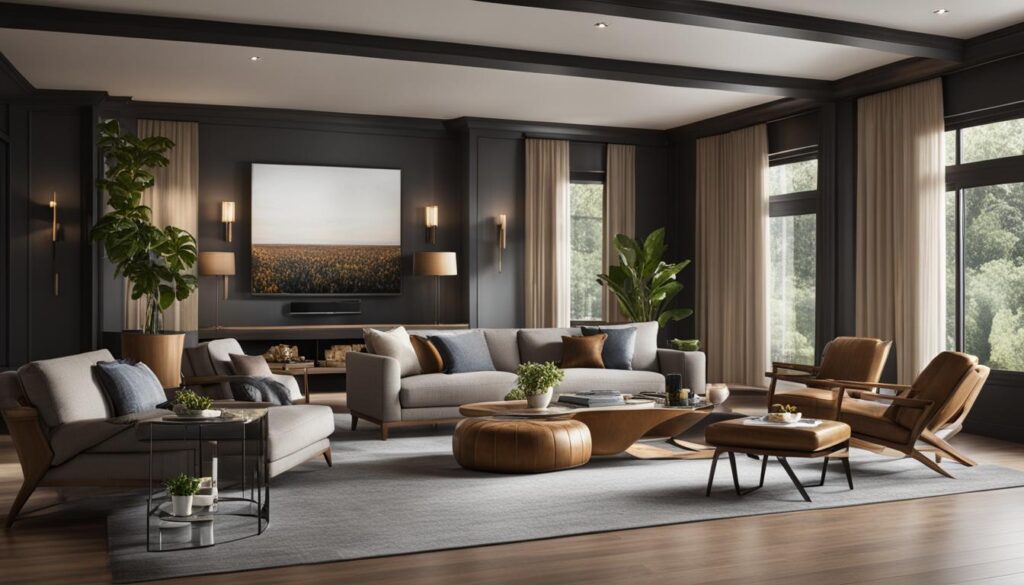Arranging living room furniture with a TV can be a daunting task, but there are simple principles that can help you create a practical and aesthetically pleasing layout. Consider different living room furniture arrangement examples such as symmetrical, floating, L-shaped, and layouts for irregular and long narrow rectangular rooms. Create a focal point in your room and position your TV in an area unaffected by sunlight or glare. Ensure that there is enough space between furniture and walls for a comfortable viewing experience. Arrange seating areas in a way that promotes easy conversation and balance in the room. Use area rugs under furniture, especially in seating arrangements. Choose a coffee table and side tables that are the appropriate height for seating. Incorporate a mix of overhead lighting, floor lamps, and table lamps for balanced lighting. Consider the placement of artwork and mirrors in proportion to the furniture. Use a floor planner or sketch your floor plan to better visualize furniture placement before moving it.
Table of Contents
Key Takeaways:
- Consider different living room furniture arrangement examples such as symmetrical, floating, L-shaped, and layouts for irregular and long narrow rectangular rooms.
- Create a focal point in your room and position your TV in an area unaffected by sunlight or glare.
- Ensure there is enough space between furniture and walls for a comfortable viewing experience.
- Arrange seating areas in a way that promotes easy conversation and balance in the room.
- Use area rugs under furniture, especially in seating arrangements.
Furniture Arrangement Tips for Successful Living Room Layouts
When it comes to arranging furniture in your living room, there are a few tips that can help you create a successful layout, especially when incorporating a TV. The first step is to define the traffic flow in your space and ensure that furniture placement doesn’t obstruct movement. Once you have a clear path, it’s time to determine the main focal point of the room. This could be a fireplace, window, artwork, or, in this case, a TV.
Start by drawing a diagram of your living room layout to plan where each piece of furniture will go. Begin with the larger furniture items that may have limited placement options. When positioning your TV, consider factors such as visibility and glare. You can explore various options for living rooms with fireplaces and TVs, such as placing the TV above the fireplace, on the wall next to the fireplace, or on the wall opposite the fireplace.
To create a comfortable and functional seating area, arrange your furniture in a way that promotes conversation and balance. You can achieve this by forming a U-shape with your seating or grouping chairs at 90-degree angles. Ensure that there is a clear path for traffic flow between furniture pieces and that everyone has access to side tables or a coffee table. If you have a small living room, you might consider using portable seating options like bean bags, pouffes, and floor cushions to maximize space and add a unique touch.
Remember, planning is key when it comes to furniture arrangement. Use a floor planner or sketch your floor plan to visualize the placement before making any physical changes. By following these tips and considering the specific characteristics of your space, you can achieve a successful living room layout that incorporates your TV seamlessly.
Furniture Arrangement Tips for Successful Living Room Layouts
- Define the traffic flow in your living room and ensure furniture doesn’t obstruct movement.
- Select a main focal point for the room, such as a fireplace or TV.
- Draw a layout diagram to plan furniture placement.
- Start with larger furniture pieces and determine the best location for the TV.
- Create a conversation area by arranging seating in a U-shape or grouping chairs at angles.
- Ensure clear paths for traffic flow and provide access to side tables or a coffee table.
- Consider using portable seating options for small rooms.
- Use a floor planner or sketch your floor plan to visualize furniture placement.
By following these furniture arrangement tips and considering the unique characteristics of your living room, you can create a successful layout that incorporates your TV in a practical and aesthetically pleasing way.
| Furniture Arrangement Tips for Successful Living Room Layouts | Summary |
|---|---|
| Define traffic flow in the living room | Ensure furniture placement doesn’t obstruct movement |
| Choose a main focal point | Consider a fireplace or TV |
| Plan furniture placement | Use a layout diagram or floor planner |
| Start with larger furniture pieces | Determine optimal TV location |
| Create a conversation area | Arrange seating in a U-shape or angled grouping |
| Ensure clear paths | Provide access to side tables or coffee table |
| Consider portable seating options | Maximize space in small rooms |
| Visualize furniture placement | Use a floor planner or sketch floor plan |
Unique Furniture Layout Ideas for TV Rooms
When it comes to arranging furniture in your TV room, it’s important to think outside the box and consider the unique characteristics of your space. Here are some creative layout ideas that can help you make the most of your living room and create a comfortable and inviting atmosphere.
If you have a narrow room, a slimline layout can be the perfect solution. Place a loveseat or a longer sofa against the wall opposite the TV to maximize space. Another option is to install a tailor-made corner entertainment nook with a sofa and a wall-hugging ledge, providing extra seating without taking up too much space.
In a deep room, consider experimenting with sectioned seating. Place solo seats in the front and a sofa at the back to create a layered effect and optimize viewing angles. An L-shaped layout is also a great choice, with the TV positioned on the same wall as the fireplace or opposite it.
If you have a large living room, U-shaped layouts with sectional sofas or a combination of a traditional sofa set and a futon or sofa bed can be a stylish and practical option. For added depth and visual variety, try creating a two-level seating arrangement with floor recliners and sofas. This can add a unique touch to your TV room.
FAQ
How do I arrange my living room furniture with a TV?
Consider different furniture arrangement examples such as symmetrical, floating, L-shaped, and layouts for irregular and long narrow rectangular rooms. Create a focal point in your room and position your TV in an area unaffected by sunlight or glare. Ensure there is enough space between furniture and walls for a comfortable viewing experience. Arrange seating areas in a way that promotes easy conversation and balance in the room.
What should I consider when placing my TV in the living room?
Ensure that there is enough space between the TV and seating area for optimal viewing distance. Avoid placing the TV in an area where it is affected by direct sunlight or glare. Consider the layout of the room and the location of other furniture to find the best placement for the TV.
How do I create a conversation area in my living room?
Arrange your seating in a U-shape or group chairs at 90-degree angles to create a conversation area. Ensure that there is a clear path for traffic flow between furniture and that everyone has access to side tables or a coffee table.
What types of lighting should I incorporate in my living room?
Use a mix of overhead lighting, floor lamps, and table lamps to achieve balanced lighting in the room. This will provide both ambient and task lighting for different activities in the space.
How can I visualize furniture placement before moving it?
Use a floor planner or sketch your floor plan to better visualize furniture placement before physically moving it. This can help you determine the best layout and prevent unnecessary rearranging.

